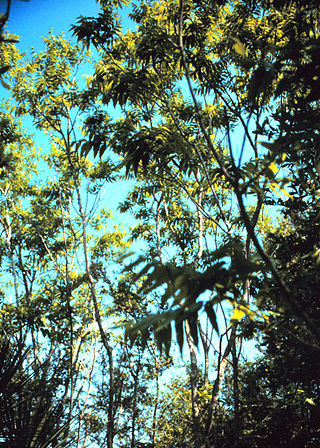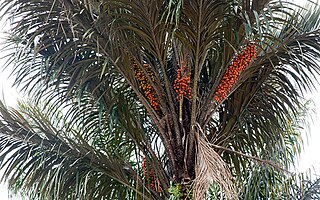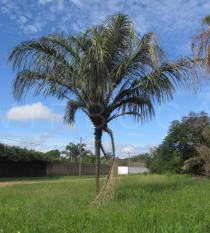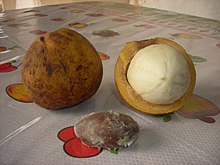
A mango is an edible stone fruit produced by the tropical tree Mangifera indica. It is believed to have originated between northwestern Myanmar, Bangladesh, and northeastern India. M. indica has been cultivated in South and Southeast Asia since ancient times resulting in two types of modern mango cultivars: the "Indian type" and the "Southeast Asian type". Other species in the genus Mangifera also produce edible fruits that are also called "mangoes", the majority of which are found in the Malesian ecoregion.

The papaya, papaw, or pawpaw is the plant species Carica papaya, one of the 21 accepted species in the genus Carica of the family Caricaceae. It was first domesticated in Mesoamerica, within modern-day southern Mexico and Central America. In 2020, India produced 43% of the world's supply of papayas.

Morchella, the true morels, is a genus of edible sac fungi closely related to anatomically simpler cup fungi in the order Pezizales. These distinctive fungi have a honeycomb appearance due to the network of ridges with pits composing their caps. Morels are prized by gourmet cooks, particularly in Catalan and French cuisine. Due to difficulties in cultivation, commercial harvesting of wild morels has become a multimillion-dollar industry in the temperate Northern Hemisphere, in particular North America, Turkey, China, the Himalayas, India, and Pakistan where these highly prized fungi are found in abundance.

The Clusiaceae or GuttiferaeJuss. (1789) are a family of plants including 13 genera and ca 750 species. Several former members of Clusiacae are now placed in Calophyllaceae and Hypericaceae. They are mostly trees and shrubs, with milky sap and fruits or capsules for seeds. The family is primarily tropical. More so than many plant families, it shows large variation in plant morphology. According to the APG III, this family belongs to the order Malpighiales.

Artocarpus integer, commonly known as chempedak or cempedak, is a species of tree in the family Moraceae in the same genus as breadfruit and jackfruit. It is native to Southeast Asia. Cempedak is an important crop in Malaysia and is also popularly cultivated in southern Thailand and parts of Indonesia, and has the potential to be utilized in other areas. Cempedak is currently limited in range to Southeast Asia, with some trees in Australia and Hawaii.

Morchella esculenta, is a species of fungus in the family Morchellaceae of the Ascomycota. It is one of the most readily recognized of all the edible mushrooms and highly sought after. Each fruit body begins as a tightly compressed, grayish sponge with lighter ridges, and expands to form a large yellowish sponge with large pits and ridges raised on a large white stem. The pitted yellow-brown caps measure 2–7 centimetres broad by 2–10 cm (1–4 in) tall, and are fused to the stem at its lower margin, forming a continuous hollow. The pits are rounded and irregularly arranged. The hollow stem is typically 2–9 cm long by 2–5 cm (1–2 in) thick, and white to yellow. The fungus fruits under hardwoods and conifers during a short period in the spring, depending on the weather, and is also associated with old orchards, woods and disturbed grounds.

Chrysophyllum cainito is a tropical tree of the family Sapotaceae. It is native to the Isthmus of Panama, where it was domesticated. It has spread to the Greater Antilles and the West Indies and is now grown throughout the tropics, including Southeast Asia. It grows rapidly and reaches 20 meters in height.

Sapindus is a genus of about five to twelve species of shrubs and small trees in the lychee family, Sapindaceae, native to warm temperate to tropical regions of the world. The genus includes both deciduous and evergreen species. Members of the genus are commonly known as soapberries or soapnuts because the fruit pulp is used to make soap. The generic name is derived from the Latin words sapo, meaning "soap", and indicus, meaning "of India".

Pouteria caimito, the abiu, is a tropical fruit tree originated in the Amazonian region of South America. It grows to an average of 10 metres (33 ft) high, and can grow as high as 35 metres (115 ft) under good conditions. Its fruits' shape varies from round to oval, pointed at the distal end. When ripe, it has smooth, bright yellow skin and has one to four ovate seeds. The inside of the fruit is translucent and white. It has a creamy and jelly-like texture and its taste is similar to the sapodilla — a sweet caramel custard. The abiu tree is part of the family Sapotaceae and is very similar in appearance to the canistel.

The white sapote, scientific name Casimiroa edulis, also called casimiroa and Mexican apple, and known as cochitzapotl in the Nahuatl language is a species of tropical fruiting tree in the family Rutaceae, native to eastern Mexico and Central America south to Costa Rica. The genus is named for "an Otomi Indian, Casimiro Gómez, from the town of Cardonal in Hidalgo, Mexico, who fought and died in Mexico's war of independence."

Eugenia luschnathiana is a flowering plant in the family Myrtaceae, native to the state of Bahia, Brazil. The fruit is known as pitomba-da-bahia, and is also called uvalha do campo, ubaia do campo or uvalheira in Brazil. It shares the name pitomba with another South American species, Talisia esculenta.

Astrocaryum vulgare is a very spiny palm native to the Guianas and the Amazon. It is species which has greatly benefited from deforestation, as it cannot grow in undisturbed rainforest. In Brazil it is considered typical of Pará state in the north of the lower Amazon. This plant has edible fruit.

Astrocaryum murumuru is a palm native to Amazon Rainforest vegetation in Brazil, which bears edible fruits. Murumuru butter, extracted from the seeds of the plant, may be used as a moisturizer. One remarkable feature of this palm is that it is covered with spines up to twelve inches in length.

Astrocaryum aculeatum is a palm native to tropical South America and Trinidad. It grows up to 15 m (49 ft) tall and is usually solitary. It has ascending leaves, erect inflorescence, and yellow fruit.

Mangifera indica, commonly known as mango, is a species of flowering plant in the family Anacardiaceae. It is a large fruit tree, capable of growing to a height of 30 metres. There are two distinct genetic populations in modern mangoes – the "Indian type" and the "Southeast Asian type".

Morchella rufobrunnea, commonly known as the blushing morel, is a species of ascomycete fungus in the family Morchellaceae. A choice edible species, the fungus was described as new to science in 1998 by mycologists Gastón Guzmán and Fidel Tapia from collections made in Veracruz, Mexico. Its distribution was later revealed to be far more widespread after several DNA studies suggested that it is also present in the West Coast of the United States, Israel, Australia, Cyprus, Malta and Switzerland.

Manilkara huberi, also known as masaranduba, níspero, and sapotilla, is a fruit bearing plant of the genus Manilkara of the family Sapotaceae.

Padre Manuel Arruda da Câmara was a Brazilian cleric, physician and scientist, who became known as one of the great Brazilian botanists of the late eighteenth century.
Butia arenicola is a very small species of Butia palm with an underground trunk; native to Paraguay and the state of Mato Grosso do Sul in Brazil. Boquierinho is recorded as a possible local vernacular name for it.





















